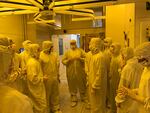
A group of high school students visits Jireh Semiconductor in 2019. Jireh is part of an apprenticeship program at Hillsboro's Century High School, aimed at building the next generation of clean-room technicians.
Courtesy of Jireh Semiconductor
High schoolers don’t usually help manufacture semiconductors.
But in tech-heavy Hillsboro, where companies have about 800 job openings in advanced manufacturing, that’s about to change — at least for six students at Century High School.
The Hillsboro School District announced Monday it’s launching Oregon’s first registered youth apprenticeship in advanced manufacturing, in partnership with the City of Hillsboro and local industry. The Hillsboro Advanced Manufacturing Apprenticeship was approved by the Oregon Bureau of Labor & Industries this spring.
Teenagers who complete the two-year program will be certified to work as manufacturing technicians — entry-level workers in such short supply that Intel even ran ads during Sunday Night Football to find them.
“Everyone’s desperate for talent and that’s only going to expand,” said Kristi Wilson, a city workforce development official who helped build the apprenticeship program.
When people think of jobs at Intel, Oregon’s largest private employer, they often think of highly paid engineers. But Intel and other semiconductor companies rely heavily on the factory technicians in head-to-toe bunny suits who make the computer chips that run modern life.
The path to those jobs can be “invisible” to the state’s youngest students, Wilson said.
“We’ve been talking about the pipeline for a long time,” she said. “And there isn’t a lot of semiconductor pathways in K-12.”
The apprenticeship’s first cohort of 11th graders will continue receiving classroom education at Century High. They’ll also work alongside mentors at Hillsboro-based Jireh Semiconductor and supplier Tosoh Quartz, earning $16 an hour to start. After graduating high school, the students can continue working for the companies for $18 an hour or take their skills elsewhere.
Intel actively supported the program’s creation but isn’t ready to host a youth apprentice yet, Wilson said.
Jireh Semiconductor will host three.
“We’ve gotten away from really giving students the opportunity to explore what they want to do,” said the company’s recruiting manager Lynn Nelson. “For too many years it was the focus that everybody needed college.”
Nelson said Jireh technicians in their first year of employment can earn around $50,000, especially if they’re willing to work overnight. Jireh’s 12-hour shifts, he said, come with built-in overtime pay. He said the company provides opportunities for technicians to advance.
Officials like Hillsboro mayor Steve Callaway have lauded the apprenticeship program as fostering a diverse talent pipeline and a pathway to living-wage jobs. That pipeline could become even more important as the semiconductor industry in Oregon gears up to invest federal dollars from the $280 billion CHIPS and Science Act.
The apprenticeship program has limits. Right now, it is only available to students at Century High who are enrolled in a specific career and technical education program. The goal is to expand access to each of Hillsboro’s high schools.
The first group of students all identify as male, according to program officials.
It’s the goal of Claudia Rizo, the school district’s youth apprenticeship project manager, to promote the program to students who’ve been traditionally underrepresented in advanced manufacturing, particularly young women. That will mean recruiting girls as they transition from middle to high school.
“Students can’t really be what they can’t see,” she said.
